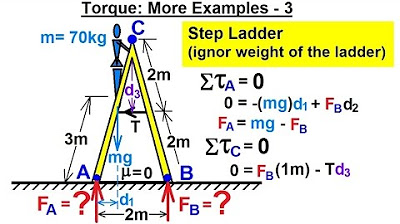Physics 15 Torque Example 7 (7 of 7) The Ladder Problem (should be cos(15) at end)
TLDRIn this engaging lecture, the presenter explores the dynamics of torques using the classic ladder problem, which involves a 30 kg ladder and an 80 kg person. The problem is set at a 15-degree angle with the vertical, and the coefficient of friction between the ladder and the floor is 0.3. The lecturer methodically calculates the forces acting on the ladder, including gravity, normal force, and friction, to determine whether the ladder will slip when the person is one-third of the way up. The analysis reveals that the ladder will not slip at this point due to sufficient friction. Furthermore, the presenter extends the problem to consider if the person can reach the top of the ladder without causing it to slide. The calculations show that the ladder remains stable even when the person is at the top, provided the coefficient of friction remains constant. This detailed exploration of torques and forces not only provides a practical application of physics but also emphasizes the importance of understanding these principles for safety when climbing ladders.
Takeaways
- 📐 **Ladder and Person Mass**: The ladder has a mass of 30 kg, and the person climbing has a mass of 80 kg.
- 🧱 **Friction Coefficient**: The coefficient of friction between the ladder and the floor is given as 0.3.
- 🧷 **Friction Assumption**: It's assumed there's no friction between the ladder and the wall, as walls are typically smooth.
- 📐 **Ladder Angle**: The ladder is placed at a 15-degree angle with the vertical.
- ⚖️ **Forces Acting on Ladder**: The forces considered are gravity on the person and ladder, normal force, friction force, and force of the wall on the ladder.
- 🔄 **Torque Calculation**: Torque is calculated around a pivot point, with clockwise torque considered positive and counterclockwise negative.
- 🔢 **Normal Force Calculation**: The normal force is the sum of the weights of the person and the ladder, which equals 1078 N.
- 🔩 **Friction Force Calculation**: The friction force is the product of the normal force and the friction coefficient (0.3), resulting in 323.4 N.
- 🚫 **Ladder Stability**: When the person is one-third up the ladder, the force exerted by the wall on the ladder is less than the friction force, so the ladder does not slip.
- 🔺 **Force on Wall with Person at Top**: When the person reaches the top, the force on the wall is recalculated and is still less than the friction force, allowing the person to reach the top safely.
- ⚠️ **Surface Conditions**: The safety of the ladder slipping is contingent on the surface being dry and the coefficient of friction remaining at 0.3.
Q & A
What is the mass of the ladder in the problem?
-The mass of the ladder is 30 kilograms.
What is the mass of the person climbing the ladder?
-The person climbing the ladder has a mass of 80 kilograms.
What is the coefficient of friction between the ladder and the floor?
-The coefficient of friction between the ladder and the floor is 0.3.
What is the angle of the ladder with the vertical?
-The angle of the ladder with the vertical is 15 degrees.
At what point does the person reach on the ladder in Part A of the problem?
-In Part A, the person reaches 1/3 of the way up the ladder.
What is the normal force acting on the ladder?
-The normal force acting on the ladder is equal to the combined weight of the ladder and the person, which is 1078 Newtons.
What is the friction force that prevents the ladder from sliding?
-The friction force that prevents the ladder from sliding is 323.4 Newtons, calculated as the normal force times the coefficient of friction.
What is the force of the wall acting on the ladder?
-The force of the wall acting on the ladder, when the person is 1/3 of the way up, is 109.4 Newtons.
Can the ladder slide when the person is 1/3 of the way up?
-No, the ladder will not slide when the person is 1/3 of the way up because the force of the wall is less than the friction force.
What changes when the person climbs to the top of the ladder?
-When the person climbs to the top of the ladder, the distance from the person's weight force to the pivot point (distance one) changes, becoming equal to the length of the ladder times the sine of the angle.
Can the person climb to the top of the ladder without the ladder slipping?
-Yes, the person can climb to the top of the ladder without it slipping, as the force on the wall (249.5 Newtons) is still less than the friction force (323.4 Newtons).
What assumption is made about the friction between the wall and the ladder?
-The assumption made is that there is no friction between the wall and the ladder, as walls are typically smooth and the ladder could easily slide along the wall.
Outlines
📚 Introduction to the Sliding Ladder Problem
The first paragraph introduces the sliding ladder problem, also known as the lather problem, which is a practical and safety-related issue when climbing ladders. It sets the stage by presenting a scenario where a 30 kg ladder and an 80 kg person are involved, with friction present on the floor but not against the wall. The ladder is placed at a 15-degree angle to the vertical, and the problem is to determine if the ladder will slip when the person is one-third of the way up, and if the person can reach the top without the ladder slipping. The approach involves calculating torques about a pivot point, considering forces of gravity, normal force, friction, and the force of the wall pushing back against the ladder.
🔍 Calculating Forces and Torques to Prevent Ladder Slipping
The second paragraph delves into the calculation of forces and torques to determine the conditions under which the ladder will not slip. It explains the process of summing forces in the vertical direction to find the normal force, which is then used to calculate the friction force. The paragraph also discusses the horizontal forces, particularly the force of the wall against the ladder and the friction force preventing the ladder from sliding. The key is to calculate the torque caused by the person's weight and the ladder's weight about a chosen pivot point and compare it with the torque due to the force of the wall to decide if the ladder will slide or not.
🧮 Determining the Safety of Climbing to the Top
The third paragraph focuses on the calculations needed to determine if the person can safely climb to the top of the ladder without it slipping. It involves adjusting the distances from the pivot point to the lines of action of the forces as the person's position on the ladder changes. The force on the wall is calculated for both scenarios: when the person is one-third of the way up and when they are at the top. The results are compared with the friction force to ensure it is less than the frictional force, indicating that the ladder will not slide. The paragraph concludes that as long as the coefficient of friction remains constant and the surface is dry, the ladder will remain stable, allowing the person to climb safely to the top.
Mindmap
Keywords
💡Torque
💡Friction
💡Coefficient of Friction (μ)
💡Normal Force
💡Ladder Stability
💡Pivot Point
💡Gravity
💡Mass
💡Angle of Incline
💡Sliding Ladder Problem
💡Static Equilibrium
Highlights
Introduction to the ladder problem, also known as the sliding ladder problem, which is both a practical and theoretical physics problem.
Assumption that the ladder has a mass of 30 kilograms and the person climbing has a mass of 80 kilograms.
The coefficient of friction between the ladder and the floor is given as 0.3, with the assumption of no friction against the wall.
The ladder is placed at a 15-degree angle with the vertical, which is crucial for the torque calculations.
Part A of the problem asks if the ladder will slip when the person reaches one-third of the way up.
The sum of torques about the pivot point is set to zero to analyze the forces acting on the ladder.
Identification of forces acting on the ladder: gravity, normal force, friction force, and the force of the wall.
Calculation of the normal force as the sum of the weights of the ladder and the person.
Determination of the friction force using the normal force and the coefficient of friction (μ = 0.3).
The ladder will not slide if the force exerted by the wall on the ladder is greater than the friction force.
Use of torque equations to find the force on the wall and compare it with the friction force to assess if the ladder slips.
Calculation of distances (d1, d2, d3) based on the geometry of the problem and the position of the person on the ladder.
For Part B, the person's position changes to the top of the ladder, altering the distances and the force on the wall.
The force on the wall must be less than the friction force for the ladder to remain stationary.
Final calculation shows the force on the wall is less than the friction force, so the ladder does not slide.
Practical implications discussed, such as the ladder's safety during climbing and the effect of varying the coefficient of friction.
Conclusion that the person can climb to the top of the ladder without it sliding, given the conditions remain constant.
Transcripts
Browse More Related Video

The Leaning Ladder Problem | Physics with Professor Matt Anderson | M12-22

Physics 15 Torque (21 of 25) More Examples: 3 T=? of Cable of Step Ladder

Leaning Ladder Equilibrium Problem: Find Minimum Angle

Ladder Example for Static Equilibrium

Torque Example #3: Leaning Ladder Problem

Solving a falling ladder problem using related rates
5.0 / 5 (0 votes)
Thanks for rating: